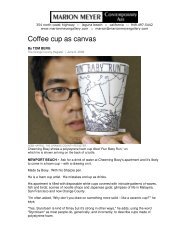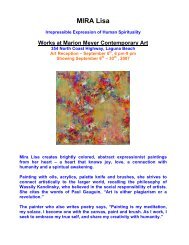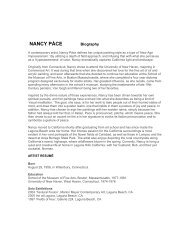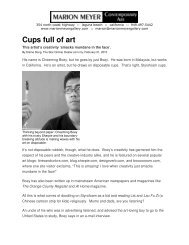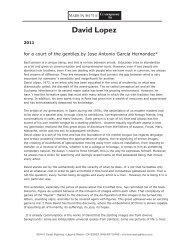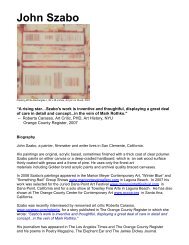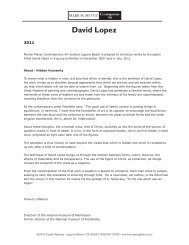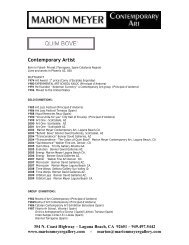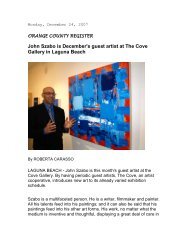INTERIOR DAVID LOPEZ tz - Marion Meyer Contemporary Art
INTERIOR DAVID LOPEZ tz - Marion Meyer Contemporary Art
INTERIOR DAVID LOPEZ tz - Marion Meyer Contemporary Art
You also want an ePaper? Increase the reach of your titles
YUMPU automatically turns print PDFs into web optimized ePapers that Google loves.
Para un atrio de los<br />
gestiles. Fragmentos<br />
Jose Antonio Garcia Hernandez*<br />
For an atrium of the<br />
gentiles. Fragments<br />
Jose Antonio Garcia Hernandez*<br />
Cada persona es un ser singular, y esto no lo es menos<br />
entre los artistas. La educación trata de uniformizarnos<br />
un poco, de darnos herramientas de comunicación y<br />
comprensión. Pero aunque dos personas sean hermanos<br />
gemelos, aunque tratemos con personas con las que<br />
tenemos mucho en común, siempre encontramos<br />
abismos de diferencia. Son necesarios puentes que<br />
enlacen las distancias entre lo que es muy significativo<br />
para una sensibilidad e insignificante para otra.<br />
David López, 1972, es un artista que se ha formado en<br />
la crisis de la modernidad, o lo que se llamó<br />
dramáticamente el descrédito de las vanguardias. El<br />
llamado arte conceptual y toda la herencia duchampiana<br />
-en su segundo gran envite- ha sido su entorno de cultivo,<br />
sin embargo no ha tenido las carencias formativas que<br />
se dan en tantos artistas donde el corte con la tradicion<br />
ha sido contundente. A esto se añade un patrimonio de<br />
recursos y experiencias resultante de haber vivido en<br />
París, profundizando con entusiasmo en estos<br />
conocimientos.<br />
Los artistas de mi generación, años 70, en España, la<br />
asimilación de los maestros modernos debíamos hacerla<br />
por vía paralela, mediante visita a exposiciones,<br />
correspondencia con amigos en el extranjero, largas<br />
conversaciones de cafetería y muchas lecturas.. Uno es<br />
hijo de su tiempo y tiene siempre el deje de su lengua<br />
materna, algo así como una plataforma de salida. Otro<br />
aspecto no menos significativo es que mi generación<br />
recibió el primer gran shock de la divulgación de los<br />
padres de la sospecha, Freud, Marx, Nie<strong>tz</strong>sche, la clave<br />
de los nihilismos posteriores.<br />
David López es hijo de su tiempo y tiene la base de su<br />
lengua materna (en cuanto lenguaje y problemática<br />
artística), por tanto la apropiación de objetos, el resignificar<br />
imágenes conocidas, el cruzar las fronteras de<br />
la especialización moviéndose del video a la instalación,<br />
del dibujo a la transferencia, o a la mezcla de todo esto,<br />
ya sea collage o bricolage, le resulta completamente<br />
Each person is a unique being, and this is<br />
no less between artists. Education tries to<br />
standardize us a bit and gives us<br />
communication and comprehension tools.<br />
However, even if two people are identical<br />
twin brothers, even if we are dealing with<br />
people who we have much in common, we<br />
always find chasms of difference. They are<br />
necessary bridges that connect the gap<br />
between what is very important for someone´s<br />
sensibility and insignificant for another.<br />
David López, 1972, is an artist who has been<br />
educated in the crisis of modernity, or what<br />
was dramatically called, the discredit of the<br />
avant-guarde. The so-called conceptual art<br />
and all the Duchamp inheritance in its second<br />
major stake has been his growing<br />
environment. However, he hasn´t had the<br />
formative gaps that exist with many artists in<br />
which the cut with tradition has been strong.<br />
In addition, his time spent living in Paris has<br />
given him a wealth of resources and<br />
experiences and has enthusiastically<br />
deepened his knowledge.<br />
The artists of my generation, in Spain during<br />
the 1970s, the assimilation of us modern<br />
masters had to be done in a parallel way,<br />
through visits to exhibitions, correspondence<br />
with foreign friends, long conversations in<br />
cafes, and many lectures. Each person is a<br />
son of his time and always has the accent of<br />
his own mother tongue as a starting platform.<br />
Another equally significant aspect is that my<br />
generation received the first great shock of<br />
disclosure from the fathers of suspect, Freud,<br />
Marx, Nie<strong>tz</strong>sche, which was the key to<br />
subsequent nihilisms.<br />
David López is a son of his time and has the<br />
foundation of his mother tongue (as regards<br />
language and artistic problems) therefore the<br />
appropriation of objects, the re-signifying of
natural. No tiene que hacerse ninguna violencia: así se<br />
expresa. Más, siempre con tensión de búsqueda,<br />
experimentando arriesgadamente en éste ser poseído<br />
que a todo artista mueve.<br />
David se interroga por la autenticidad y la veracidad de<br />
lo que hace. No es que lucha sólo y a cualquier precio<br />
para hacerse un hueco en este competitivo y duro mundo<br />
globalizado. No es esa la cuestión: todo ser humano<br />
lucha, y todo artista es hombre. Sin embargo es de un<br />
modo particular como él lo está haciendo.<br />
Esta exposición, sobre todo la serie de piezas sobre el<br />
Crucificado, me ha hecho recordar el libro Discurso,<br />
Figura de Lyotard por la inclusión de imágenes unas en<br />
otras. Esa complejidad de juegos de lo "figural", gracias<br />
al hallazgo de la des-figuración de las imágenes para<br />
convertirse en letras, signos sonoros; y luego el revestirse<br />
nuevamente de figuras. Esta conmoción a mí me resultaba<br />
un juego apasionante. Creo que David ha encontrado<br />
este hallazgo donde la corporeidad del Cristo se muestra<br />
capaz de asumir toda la humanidad, sus sufrimientos,<br />
sus gozos, sus esperanzas.<br />
Es ya algo frecuente en las obras de David, que las<br />
imágenes de partida sean de diversa procedencia: unas<br />
son citas de pintores universales indiscutibles, otras son<br />
imágenes de la vida mas intima. Es un curioso entrechocar<br />
- y un productivo entrechocar- de estos dos mundos,<br />
de lo vivo privado o íntimo con aquello que se hace o<br />
que se ha hecho universal -imágenes muy reconocibles<br />
de la historia del arte- pero que quieren ser rescatados<br />
como emblema de la dignidad humana, porque en la<br />
genialidad de los grandes artistas, la belleza y grandeza<br />
de sus obras, se dignifica toda la especie, nos sentimos<br />
partícipes de un linaje capaz de alcanzar cotas muy altas.<br />
Mediante las citas se realiza un nuevo discurso acerca<br />
de la vida; y sobre todo, lo fundamental en todo esto:<br />
David pone la vida por encima del arte.<br />
Todo artista, por naturaleza, tiende a hacer un ídolo de<br />
su quehacer. Su vida se sacrifica en aras de su arte.<br />
Pero David está tratando de que el arte sirva a la vida,<br />
como un juego, como una fiesta o celebración, incluso<br />
como una liturgia, que es el lugar de encuentro de las<br />
artes. En lugar de alinearse en la llamada "cultura de la<br />
queja" (R. Hugues), se sitúa en la cultura del asombro y<br />
la bendición, y esta es la novedad.<br />
known images, the crossing of boundaries<br />
of specialization moving away from video to<br />
installation, from drawing to transfer, or a<br />
mixture of all this, whether it be a collage or<br />
bricolage, it comes to him as something<br />
completely natural. He doesn´t need to force<br />
himself; this is the way he expresses himself.<br />
Moreover, he always has a strain for searching<br />
and daringly experiments on that possessed<br />
being that moves every artist.<br />
David stands out by the authenticity and the<br />
veracity of what he does. It´s not that he<br />
battles only and at whatever cost in order to<br />
gain a foothold in this hard and competitive<br />
globalized world. That is not the question;<br />
every human being struggles and every artist<br />
is a man. However, he is doing it in a very<br />
particular way.<br />
This exhibition, especially the series of pieces<br />
about the Crucified One, has reminded me<br />
of the book Discurso, Figura de Lyotard<br />
because of the inclusion of images within<br />
each other. That complexity of games of the<br />
“figural”: thanks to the discovery of the defiguration<br />
of the images to be turned into<br />
letters, sounding signs, and later to be<br />
covered again with figures. This great<br />
upheaval was an exciting game to me. I think<br />
David has found this discovery, where the<br />
embodiment of Christ is shown capable of<br />
assuming all of humanity, its sufferings, its<br />
joys, its hopes.<br />
It is already commonplace in the works of<br />
David that the starting images are from diverse<br />
backgrounds: some are indisputable universal<br />
quotes from painters; some are pictures of<br />
life´s most intimate moments. It's a curious<br />
clash - and a productive clash-of these two<br />
worlds, the private or intimate living with what<br />
is made or that has been made universalvery<br />
recognizable images in the history of<br />
art- but that want to be rescued as an emblem<br />
of human dignity, because the genius of great<br />
artists, the beauty and grandeur of their works,<br />
dignifies all species. We feel part of a lineage<br />
able to reach great heights. By means of the<br />
quotes a new discourse about life is realized,<br />
and above all, the key to all this: David puts<br />
his life above art.
El descrédito de las vanguardias coincide con el descrédito<br />
de la revolución social, con el dejar de creer que sea<br />
factible la utopía de Marx, un bienestar igualitario para<br />
todos. Porque empeoran las cosas en lugar de mejorar;<br />
millones de víctimas y nada. La experiencia de Nova<br />
Huta en Cracovia, precisamente, ha sido para David la<br />
sacudida que ha inspirado esta exposición. Un prototipo<br />
comunista de ciudad sin Dios, como tantas otras, donde<br />
el pueblo se reunía a celebrar en la calle, y levantaba el<br />
signo de la cruz que el gobierno derribaba repetidamente.<br />
Con todo, todavía abundan los proyectos que suponen<br />
una concepción del arte como instrumento de agitación<br />
y propaganda. Muchos artistas en nuestro tiempo saltan<br />
a la fama con la pértiga del escándalo. Andres Serrano,<br />
con su orina en “Piss Christ", es un ejemplo significativo<br />
y muy imitado.<br />
Hoy vivimos en un mundo donde la supremacía de la<br />
ciencia y de la técnica les da una posición mítica, están<br />
tomando el lugar que en el pasado ocupaban las<br />
religiones. Se reclama secularización y laicismo. La cultura<br />
globalizadora y científica se presenta como teniendo<br />
respuesta para todo. Sin embargo la ciencia no tiene<br />
nada que decir ante los grandes interrogantes de la vida<br />
y ante la inquietud existencial del hombre, la muerte. La<br />
ciencia tampoco tiene nada que decir acerca de la<br />
dignidad humana. No, los derechos humanos no están<br />
fundamentados en conocimientos científicos, son precientíficos,<br />
lo cual no quiere decir que sean irracionales.<br />
Para la ciencia el hombre puede ser transformado en un<br />
objeto y como tal objeto ser utilizado subjetivamente -<br />
el mundo de la ciencia es un mundo de hipótesis-, ser<br />
empleado a capricho y experimentar con él. No tiene<br />
valor. De ahí que es posible hablar de ‘nihilismo cientifista’<br />
(V. E. Frankl), porque queda depreciado, devaluado, el<br />
ser humano. Esta pérdida de fundamento en su ser, ya<br />
que el hombre no está programado y no se mueve por<br />
instintos, por un lado, y por otro ha perdido las<br />
coordenadas culturales que lo guiaban -la experiencia<br />
transmitida en tradiciones de cada pueblo que condensan<br />
una probada experiencia histórica colectiva- ha dejado<br />
al hombre en una situación en la que no sabe cómo vivir<br />
ni para qué vivir.<br />
El filósofo R. Spaemann anota;<br />
El lugar de la utopía como sustituto de la religión lo<br />
ocupa hoy una antiutopía radical, que rechaza<br />
totalmente la idea de la trascendencia del hombre.<br />
Every artist, by nature, tends to make an idol<br />
of his work. His life is sacrificed for the sake<br />
of his art. But David is trying to make art<br />
serve life as a game, as a party or celebration,<br />
even as a liturgy, which is the meeting place<br />
of the arts. Instead of aligning himself with<br />
the so-called "culture of complaint" (R.<br />
Hughes), he places himself in the culture of<br />
wonder and blessing, and this is the novelty.<br />
The discrediting of the avant-guarde coincides<br />
with the discrediting of the social revolution,<br />
no longer believing that Marx's utopia is<br />
feasible, an equal welfare for everyone. Why<br />
do things get worse rather than better, millions<br />
of victims and nothing. The experience of<br />
Nova Huta in Krakow in particular has been<br />
the shock that inspired David to create this<br />
exhibition. A communist prototype of a city<br />
without God, as so many others, where the<br />
people gathered together to celebrate in the<br />
street and raised the sign of the cross that<br />
was constantly pulled down by the<br />
government. However, there are still many<br />
projects that involve a conception of art as<br />
an instrument of agitation and propaganda.<br />
Many artists of our time went on to fame with<br />
the boom of scandal. Andres Serrano, his<br />
urine "Piss Christ" is a significant and widely<br />
imitated example.<br />
Today we live in a world where the supremacy<br />
of science and technology gives them a<br />
mythical position, and they are taking the<br />
place occupied in the past religions. There<br />
is a call for secularization and lacism. A<br />
globalizing and scientific culture is presented<br />
as having all the answers. However, science<br />
has nothing to say about the big questions<br />
of life and about the last existential worry of<br />
man, about death. Neither does science have<br />
anything to say about human dignity. No,<br />
human rights are not based on scientific<br />
knowledge, they are pre-scientific, which<br />
does not mean they are irrational. For science,<br />
man can be transformed into an object and<br />
as such object be used subjectively-the world<br />
of science is a hypothesis world, being used<br />
at will and experiment with him. He has no<br />
value. Hence it is possible to speak of<br />
'scientific nihilism' (VE Frankl), because the<br />
human being is depreciated and devalued.<br />
On one hand there is this loss of the
... Se trata de la imagen de los deseos de una sociedad<br />
en la que las exigencias cognitivas, éticas y religiosas<br />
de absoluto han desaparecido y en la que «nada se<br />
considera real salvo el placer y el dolor». Todo lo que<br />
importa a los hombres, todo lo que es serio para<br />
ellos, es ilusión. Ya no debemos tomarnos nada en<br />
serio. El resultado máximo de la educación es la<br />
ironía. El lugar del nihilismo heroico lo ocupa lo que<br />
yo llamaría «nihilismo banal».<br />
La conciencia de esta situación del hombre actual está<br />
condicionando la obra de artistas como David López.<br />
En gran medida esto se deja ver en esta exposición.<br />
David da una respuesta a los llamados a la tolerancia<br />
que piden respeto para todas las culturas y se<br />
avergüenzan de la propia. Algunos hemos probado<br />
esa supuesta libertad que esclaviza y esa felicidad que<br />
te deja hecho un muerto.<br />
¿Que le sucede a David?, que ha encontrado un tesoro<br />
y lo quiere compartir. ¿Cuál es este tesoro? Así lo describe<br />
Nicolás Cabasilas (Tesalónica, 1320 -1391):<br />
“Como suele ocurrir entre los hombres, que cuando<br />
el amor es desbordante y más intenso, saca de sí<br />
mismo al amante, así a Dios el amor a los hombres<br />
le sacó de sí mismo; porque no se contentó con<br />
llamar hacia El al esclavo que amaba, sino que<br />
desciende Él mismo en su busca, el Rico viene a la<br />
choza del pobre, y acercándose a él, le declara su<br />
pasión y, rechazado, no se retira; ultrajado, no se<br />
irrita; despedido, se sienta a la puerta.<br />
Nada deja de hacer para mostrar su amor; soporta<br />
los sufrimientos que se le infligen hasta la muerte (…)<br />
Lo más inaudito de todo es que no se contentó con<br />
soportar los peores sufrimientos y las heridas hasta<br />
la muerte, sino que, resucitado, después de haber<br />
rescatado su cuerpo de la corrupción, conserva en<br />
él sus llagas y sus cicatrices.<br />
Del cuerpo ha abandonado todo lo demás, pero sus<br />
cicatrices no las ha rechazado en absoluto, no ha<br />
borrado sus llagas.<br />
fundamentals in his being, since man is not<br />
programmed and does not move by instinct,<br />
and on the other hand he has lost the cultural<br />
coordinates that guided him - experience<br />
transmitted in the traditions of each people<br />
and condensed in a proven collective historical<br />
experience - and man has been left in a<br />
situation in which he doesn´t know how to<br />
live or what to live for.<br />
The philosopher R. Spaemann notes:<br />
Today the place of utopia as a substitute<br />
for religion is occupied by a radical antiutopia<br />
that completely rejects the idea of<br />
the transcendence of man. ... This is the<br />
image of the desires of a society in which<br />
the cognitive, ethical and religious<br />
demands have all completely disappeared<br />
and in which "nothing is considered real<br />
except pleasure and pain." All that matters<br />
to men, all that is serious for them is an<br />
illusion. We should not take anything<br />
seriously. The highest result of education<br />
is irony. The place of heroic nihilism is<br />
occupied by what I call "banal nihilism."<br />
Modern man´s awareness of this situation is<br />
influencing the work of artists like David López.<br />
This can be seen in this exhibition to a large<br />
extent. David gives a response to those called<br />
to tolerance, to those who demand respect<br />
for all cultures and are ashamed of their own.<br />
Some of us have tasted that false liberty that<br />
enslaves and that happiness that leaves you<br />
left for dead.<br />
What is happening to David? He has found<br />
a treasure and wants to share it. What is this<br />
treasure? Nicholas Cabasilas describes it this<br />
way (Tesalónica, 1320 -1391):<br />
"As often happens among men, when<br />
love is overwhelming and more intense,<br />
the lover is brought out of himself, as<br />
God's love towards men brought him out<br />
himself; because he was not satisfied<br />
with calling the slave who He loved<br />
towards
Al contrario, ha querido conservarlas a causa de su<br />
amor al hombre, porque con ellas ha podido encontrar<br />
al que estaba perdido, y con esas heridas ha<br />
conquistado al que amaba (…)<br />
¿Qué amor podría igualarse con ese? ¿quién concibió<br />
nunca por la belleza un amor tan loco que, en nombre<br />
de ese amor, venga a ser herido por aquel mismo al<br />
que ama, y no sólo lo soporta, no sólo conserva su<br />
amor al ingrato,sino que coloca sus heridas por<br />
encima de todo?”<br />
Este es el tesoro encontrado, el Acontecimiento y la<br />
Persona. Y así ha ocurrido en la historia. Y termino con<br />
otro párrafo de Spaemann:<br />
Him, but He descends in search of him,<br />
the Rich comes to the hut of the poor,<br />
and approaching him, he declares his<br />
passion, and rejected, he does not leave;<br />
insulted, he is not irritated; dismissed,<br />
he sits at the door. He stops at nothing<br />
to show his love; He endures the<br />
sufferings that were inflicted until death<br />
(...) What is most beyond belief is that He<br />
was not satisfied with enduring the worst<br />
sufferings and wounds until death, but<br />
once risen, after having rescued his body<br />
from corruption, he keeps his wounds<br />
and scars. He has abandoned everything<br />
else associated with the body, but He<br />
has not rejected the scars at all, He has<br />
not erased his wounds. On the contrary,<br />
he wanted to keep them because of His<br />
love towards man, because with them<br />
He was been able to find the one who<br />
was lost, and with those wounds He has<br />
won over the one He loved (...)<br />
What love could be equated with that?<br />
Who has ever imagined through beauty<br />
a love so crazy that in the name of that<br />
love, comes to be hurt by that same one<br />
who he loves, and not only withstands<br />
it, not only does he preserve his love for<br />
the ingrate, but places his wounds above<br />
everything?"<br />
This is the treasure found, the Event and the<br />
Person. And this is how it has happened in<br />
history. I finish with another paragraph from<br />
Spaemann:
Para el liberalismo banal, libertad significa multiplicación<br />
de las posibilidades de elegir. Pero no permite que<br />
se abra paso ninguna opción por la que merezca la<br />
pena renunciar a todas las demás. De una opción<br />
así habla el Evangelio, del tesoro en el campo y la<br />
valiosa perla por el que el que la encuentra lo vende<br />
todo.<br />
Fue este tesoro el que dio a la cultura europea su<br />
centro vital. Aquellos que por ese tesoro realmente<br />
lo vendieron todo fueron los santos.<br />
La Europa cristiana no estuvo formada<br />
predominantemente por santos. Al contrario. Pero<br />
existió en tanto no puso en duda que los santos<br />
habían elegido la mejor parte. Fueron ellos los que<br />
representaron la escala de valores válida en última<br />
instancia. Cuando Europa pierde este tesoro,<br />
solamente le queda el nihilismo banal, es decir, el fin<br />
de toda cultura digna de tal nombre.<br />
In banal liberalism, freedom means the<br />
multiplication of the possibilities of choice.<br />
But it doesn´t allow us to make way for<br />
any option that is worth sacrificing all the<br />
others. Such an option is mentioned in<br />
the Gospel: the treasure in the field and<br />
the valuable pearl that which the one who<br />
finds them sells everything. It was this<br />
treasure that gave European culture its<br />
vital center. Those that really sold this<br />
treasure were all saints.<br />
Christian Europe was not made up<br />
predominantly of saints. On the contrary.<br />
But there was no doubt that the saints<br />
had chosen the best part. They were the<br />
ones who represented the range of values<br />
that were ultimately valid. When Europe<br />
loses this treasure, she will only be left<br />
with banal nihilism, that is, the end of any<br />
culture worthy of that name.<br />
*es pintor y Profesor Titular de la Facultad de Bellas <strong>Art</strong>es<br />
San Carlos. Universidad Politécnica de Valencia.<br />
*Painter and Teacher of the Facultad de Bellas<br />
<strong>Art</strong>es San Carlos. Universidad Politécnica de<br />
Valencia.



